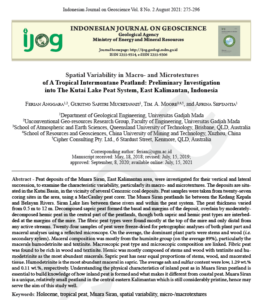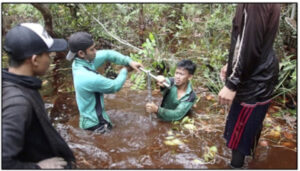Ever get that sinking feeling? Well, if you were standing in the Kutai lakes area in central Borneo you’d be right to think so.
And its not just because it is full of peat and wetlands.
Located about 100 km from the nearest coast and surrounded by low, heavily vegetated hills, that border on becoming mountains, the Kutai Lake region is slowly sinking. And I really mean sinking, in a geological sense. Depending on just how you measure it, the lowland area is between 4,500 to 8,000 km2. It is a true intermontane basin and it is incredibly understudied.
I first flew over the Kutai Lake and peatland area in 1996 and most recently visited it in 2015, leading a field trip there for The Society of Organic Petrology with my colleagues Dr Chairul Nas, Dr Hendra Amijaya and Dr Ferian Anggara (Moore, 2015).
Which brings us to this new paper: “Spatial variability in macro- and microtextures of a tropical intermontane peatland: Preliminary investigation into the Kutai Lake Peat System, East Kalimantan, Indonesia” by F. Anggara, G.S. Muchitawati, T.A. Moore, and A. Septantia , which has just been published by the Indonesian Journal on Geoscience (v. 8, No. 2, p. 275-296). It’s an open access journal so go and get the paper! – http://ijog.bgl.esdm.go.id/index.php/IJOG/article/view/681.
The work accomplished by Dr Anggara and his team from the University of Gadjah Mada (Yogjakarta, Java) is not trivial. Just getting to the field area requires several days of travel, and not the ‘sit in the airplane, then drive to the field’ sort of travel.
And once in the field, there are no comfortable hotels, heck, there isn’t even comfortable tent sites, it is a damp, though fresh, open air experience all the way.
There has been a few studies on the Kutai Lake area in the past (Hope et al., 2005; Supardi and Widjaya, 1990; Chokkalingam et al., 2005), but almost no studies look into the peat from coring and then characterize the textures and origins of the organic matter found there. More work is needed, but – pandemic permitting! – Dr Anggara and crew will be back and, if I can, so will I.
Chokkalingam, U., Kurniawan, I., Ruchiat, Y., 2005. Fire, livelihoods, and environmental change in the middle Mahakam peatlands, East Kalimantan. Ecology and Society 10, 17.
Hope, G., Chokkalingam, U., Anwar, S., 2005. The stratigraphy and fire history of the Kutai Peatlands, Kalimantan, Indonesia. Quaternary Research 64, 407-417.
Moore, T.A., 2015. A field trip guide to ancient and modern organic-rich environments in Kalimantan Timur (Borneo), Indonesia. The Soceity for Organic Petrology, ISBN 978-0-646-93901-8, Reston, Va, p. 107 pp.
Supardi, Widjaya, T., 1990. Penyelidikan endapan gambut daerah Muarakaman Prop. Kalimantan Timur. Departemen Pertambangan dan Energi, Direktorat Jenderal Geologi dan Sumberdaya Mineral, Bandung, 21pp.




Trackbacks/Pingbacks
[…] Reposted from Cipher Coal. […]